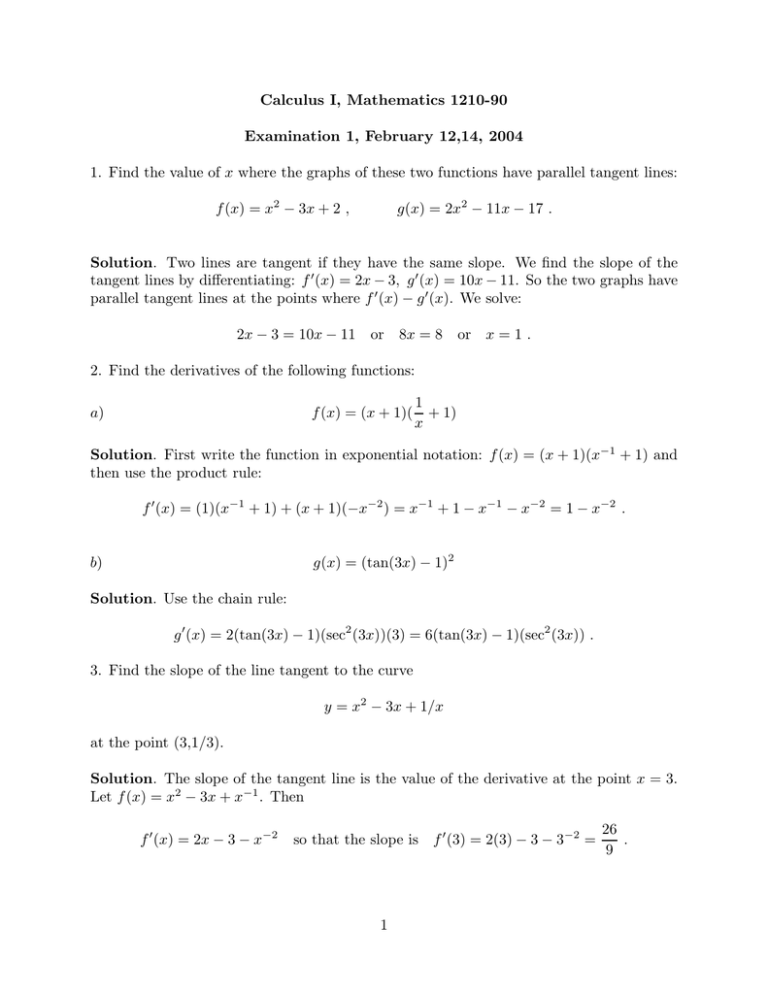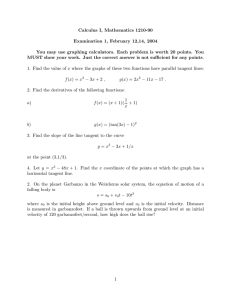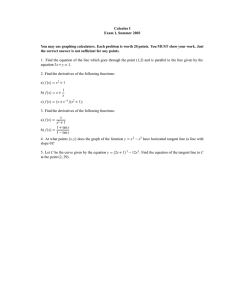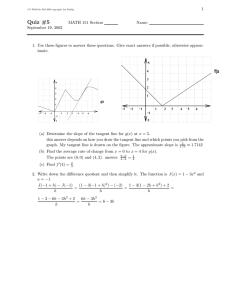Calculus I, Mathematics 1210-90 Examination 1, February 12,14, 2004
advertisement

Calculus I, Mathematics 1210-90 Examination 1, February 12,14, 2004 1. Find the value of x where the graphs of these two functions have parallel tangent lines: f (x) = x2 − 3x + 2 , g(x) = 2x2 − 11x − 17 . Solution. Two lines are tangent if they have the same slope. We find the slope of the tangent lines by differentiating: f ′ (x) = 2x − 3, g ′ (x) = 10x − 11. So the two graphs have parallel tangent lines at the points where f ′ (x) − g ′ (x). We solve: 2x − 3 = 10x − 11 or 8x = 8 or x = 1 . 2. Find the derivatives of the following functions: a) f (x) = (x + 1)( 1 + 1) x Solution. First write the function in exponential notation: f (x) = (x + 1)(x−1 + 1) and then use the product rule: f ′ (x) = (1)(x−1 + 1) + (x + 1)(−x−2 ) = x−1 + 1 − x−1 − x−2 = 1 − x−2 . g(x) = (tan(3x) − 1)2 b) Solution. Use the chain rule: g ′ (x) = 2(tan(3x) − 1)(sec2 (3x))(3) = 6(tan(3x) − 1)(sec2 (3x)) . 3. Find the slope of the line tangent to the curve y = x2 − 3x + 1/x at the point (3,1/3). Solution. The slope of the tangent line is the value of the derivative at the point x = 3. Let f (x) = x2 − 3x + x−1 . Then f ′ (x) = 2x − 3 − x−2 so that the slope is f ′ (3) = 2(3) − 3 − 3−2 = 1 26 . 9 4. Let y = x3 − 48x + 1. Find the x coordinate of the points at which the graph has a horizontal tangent line. Solution. The graph has a horizontal line where y ′ = 0. Differentiating: y ′ = 3x2 − 48, and solving 3x2 − 48 = 0 we find x = ±4. 2. On the planet Garbanzo in the Weirdoxus solar system, the equation of motion of a falling body is s = s0 + v0 t − 10t3 where s0 is the initial height above ground level and v0 is the initial velocity. Distance is measured in garbanzofeet. If a ball is thrown upwards from ground level at an initial velocity of 120 garbanzofeet/second, how high does the ball rise? Solution. We are given s0 = 0, v0 = 120, so the equation of motion is s = 120t − 10t3 . Differentiating we get the equation for velocity: v = 120 − 30t2 . At the height of the motion the velocity is 0, so we have 0 = 120 − 30t2 , so the ball is at its maximum height in t = 2 seconds. At this value of t, s = 120(2) − 10(2)3 = 160 garbanzofeet. 2


